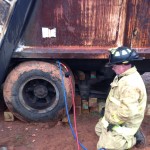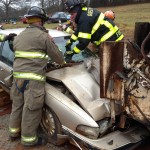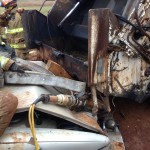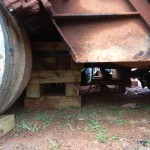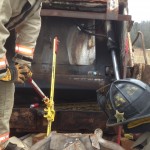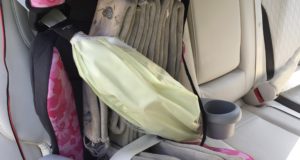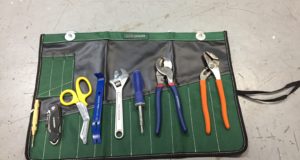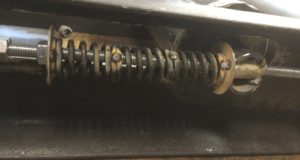 After getting home late Sunday night from the Rippin Rescue in Westminster, SC, I was hurrying to the curb with my bags of trash Monday morning just as the garbage truck rolled up. Two days earlier we were finding ways to extricate a victim pinned by a car that rear-ended the truck. I shook my head and thought to myself, self, that is some irony. Anyways, the training in SC was great even with the red mud and rain. We should certainly thank HOWELL RESCUE SYSTEMS for shipping some great tools to use for the two day event. For this post, we are going to summarize a few of the ways to extricate said victim.
After getting home late Sunday night from the Rippin Rescue in Westminster, SC, I was hurrying to the curb with my bags of trash Monday morning just as the garbage truck rolled up. Two days earlier we were finding ways to extricate a victim pinned by a car that rear-ended the truck. I shook my head and thought to myself, self, that is some irony. Anyways, the training in SC was great even with the red mud and rain. We should certainly thank HOWELL RESCUE SYSTEMS for shipping some great tools to use for the two day event. For this post, we are going to summarize a few of the ways to extricate said victim.
CHECK OUT MORE PICS HERE AND HERE
Some of the biggest challenges are the equipment you have available. The garbage truck we used in this training had a GVWR of 56,000 pounds. On a rainy day, do you think the truck might be overweight? Real quick before we dive into the techniques, what equipment do you have? How much cribbing? Struts? Airbag lifting capabilities? High-lift jacks? Heavy wreckers in the area? Mutual aid companies with additional equipment and manpower? Remember, technical rescues may require you to adapt and change plans. Think ahead to plans B, C, and D just in case plan A doesn’t work.
“LIKE” FIRST DUE TACKLE ON FACEBOOK
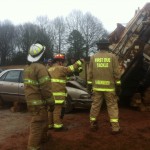
Best picture I had of the rear car cribbing. FDT gear from Tecgen Xtreme
Stabilization is always key factor in vehicle crashes and the car vs garbage truck is no different. Immediately chock the wheels of both vehicles. Crib the rear-end of the car as it is most likely lifted from the under-ride. Put wedges along side of the victim between the hood of the car and garbage truck if possible. Crib or use wedges between the garbage truck frame and top of the rear spring.
Next, one easily missed step could be capturing the car’s suspension. If you don’t capture the energy in the front end of the car; the lift you make on the garbage truck will be wasted. That is until you lift beyond the normal resting height of the car’s front end. There are multiple ways to capture the suspension, here are a few: ratchet strap from axle (steel rim) to axel (steel rim), chain from axel to axel (tension with a chain binder), or come-along. Once all these stabilization steps are taken we can get lifting. Once the suspension is captured, you can deflate the car’s front tires if they are not flat already. Be ready to drive wedges further between the car’s hood and garbage truck to gain any gap possible.
LIFTING OPTIONS
One of the options tried was to use airbags on top of the rear tires of the garbage truck. You should be cautious of using this method as you are placing more pressure on the tires. Ultimately, two airbags (13 ton and 20 ton) were not able to get the needed lift, mainly due to the controller relieving pressure on the 13 ton bag because of the load.
Another option was to place the airbag stack under the axel and rear spring. During this rotation the crew was limited to a 20 ton and 13 ton bag. They knew the 13 ton bag wasn’t able to make the lift, so they lifted several inches with the larger bag, cribbed, and reset to lift again. When they were close to freeing the victim, they used a hydraulic spreader to compress the car’s suspension enough to get the victim out.
The next lifting option tried by one of the crews was building a box crib under the center rear frame. They placed two airbags (20 ton & 26 ton) on top of the crib. The lift was quick and cribbers filled the voids as it was made. This was probably the quickest technique. Again, what are your airbags rated capabilities. Can you make this lift?
The last lifting option tried was high-lift jacks on either side of the victim. Be cautious using this technique as the placement of the jacks is critical to prevent slipping. Be sure to fill voids with cribbing and wedges. It should also be noted that this technique is not lifting the garbage truck.
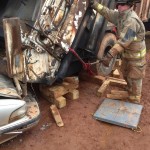 The jacks in the associated picture are rated to just over 4,000 pounds. The suspension of the car is being compressed, thus creating a gap for victim removal. This technique may not work if the under-ride is great and the car’s suspension is already bottomed out.
The jacks in the associated picture are rated to just over 4,000 pounds. The suspension of the car is being compressed, thus creating a gap for victim removal. This technique may not work if the under-ride is great and the car’s suspension is already bottomed out.
We also thought to unscrew the bolts holding the rear part of the box (the part that is raised when the truck is being emptied) to the trucks frame and use a high-lift jack on either side to push the piece up and away from the victim. It was possible to move the load, but we stopped due to the nasty water gushing out. We were mostly skeptical that this would be a worthy option in the end.
Read About A Garbage Truck Pinning In Sandusky, OH
Share this information with your crew. Preplan for this possible rescue in your area. Most if not all of us have garbage trucks rolling through our jurisdictions.
Pass it on!
 First Due Tackle Pass It On – Firefighter, Rescue & Extrication Training
First Due Tackle Pass It On – Firefighter, Rescue & Extrication Training

